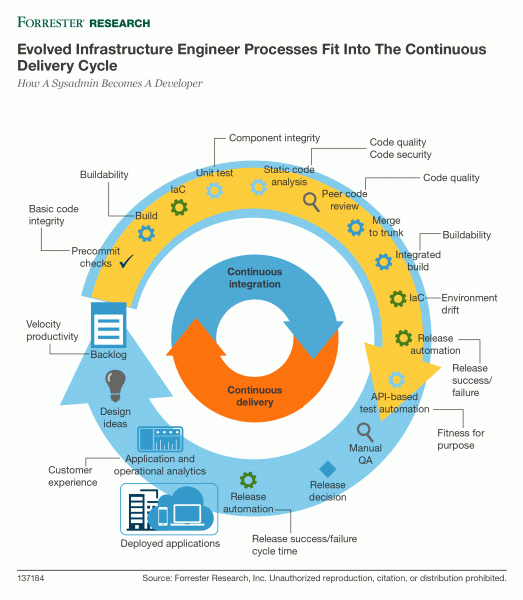The Future Of Operations: A Developer
Infrastructure is increasingly software-based with rapid container growth, composable infrastructure[i], and of course the consumption of cloud. Additionally, as the velocity of change increases – and will continue to increase – the premise that we can continue to manage these systems with our traditional methods is no longer true. The management of your estate mandates that system administrators (sysadmins) quickly acquire skill sets common among Agile development and operations (DevOps)[ii] professionals.
If You Create, You Develop – We’re All Developers Now
Back when I began in the industry, application code was opaque to computer operators (my original title, akin to modern-day systems administrators). This was the standard manner of operation then, yet too many I&O processes still perpetuate such a division. The hand-holding of systems, like babysitting mainframes, has long since fallen out of favor. The modern systems administrator is an engineer and must participate in top-to-bottom development of holistic systems using software as a base, not hardware. Admins can no longer merely watch systems process information when automated solutions do it more efficiently and are far less prone to errors. Instead, they must augment their skills with those of developers.

The Infrastructure Engineer Replaces The Systems Administrator
The adoption of cloud and the Software Defined Datacenter,[iii] is rapidly transforming the role of the sysadmin. Abstraction of hardware as software is rendering the “rack, stack, monitor and hug” priorities of the sysadmin profession obsolete. Instead, these functions are being replaced with infrastructure engineers focused on systems thinking, delivering repeatable and automated environments, focused on consistent service delivery. These professionals are leveraging good development practices such as the SDLC into their daily processes to stay relevant.
Admins: Learn From The Advances Of Developers
From continuous integration to continuous testing, to version control, developers have become very structured in their roles and at automating the mechanics of DevOps. The impact of velocity, married with the use of SDDC and Cloud, mandates that admins revitalize their careers – leveraging the good practices of the “Dev” side of DevOps including:
- Deliver smaller work packages, incorporating dynamic feedback.
- Test each and every change at all stages of the SDLC to ensure speed and quality.
- Leverage automated provisioning of environments to improve consistency, reliability, and quality.
- Automation of release processes improves velocity and error reduction
There Is Also Value To Developers
While admins can gain many insights from developers, the reverse is also true. For decades, admins have been focused on standardization, dependability, and security (too often with a slightly biased view on being risk adverse). Developers can leverage the experience in holistic, integrated product teams to deliver dependable solutions, leveraging the environments delivered by the admins to ensure that testing undertaken in development environments is reflective of production estates. The outcome of this approach is better testing – and greater confidence as releases are deployed to production environments.
In our recent report “How A Sysadmin Becomes A Developer”, Chris Gardner and I discuss the implications of the transformation of the Sysadmin role from physically building servers to the use of code to drive consistency, velocity, and quality – increasing their value and ability to meet the growing expectations of their role.
As always, I welcome your observations, comments, and experiences. You can contact me here and don’t forget to follow me on Twitter (@RobertEStroud).
[i]More information on composable infrastructure benefits, see the Forrester report “Composable Infrastructure: A Hardware Foundation For Extreme Service Agility.”
[ii]For more information on DevOps, see the Forrester report “The Need For Speed: Drive Velocity And Quality With DevOps.”
[iii]An in-depth review of the promise and potential pitfalls of the software-defined data center, see the Forrester report “The Software-Defined Data Center Is The Future Of Infrastructure Architecture.”